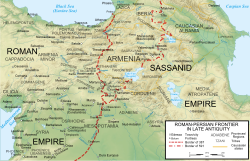Anastasian War
| Anastasian War | |||||||||
|---|---|---|---|---|---|---|---|---|---|
| Part of the Roman-Persian Wars | |||||||||
 The Roman-Persian frontier had remained stable since 384, when the two powers divided Armenia, and despite recurrent warfare, would not change significantly until the Lazic War. |
|||||||||
|
|||||||||
| Belligerents | |||||||||
| Eastern Roman Empire |
Sassanid Empire Lakhmids |
||||||||
| Commanders and leaders | |||||||||
|
Anastasius I Rufinus Areobindus Patricius Patriciolus Vitalian Hypatius Pharesmanes Celer Romanus Timostratus Constantine (POW) |
Kavadh I Theodore Al-Mundhir III ibn al-Nu'man Adergoudounbades Bawi Glones |
||||||||
The Anastasian War was fought from 502 to 506 between the Eastern Roman Empire and the Sassanid Empire. It was the first major conflict between the two powers since 440, and would be the prelude to a long series of destructive conflicts between the two empires over the next century.
Several factors underlay the termination of the longest period of peace the Eastern Roman and the Sassanid Empire ever enjoyed. The Persian king Kavadh I needed money to pay his debts to the Hephthalites who had helped him regain his throne in 498/499. The situation was exacerbated by recent changes in the flow of the Tigris in lower Mesopotamia, sparking famines and flood. When the Roman emperor Anastasius I refused to provide any help, Kavadh tried to gain the money by force.
In 502, Kavadh quickly captured the unprepared city of Theodosiopolis, perhaps with local support; the city was in any case undefended by troops and weakly fortified. Kavadh then besieged the fortress-city of Amida through the autumn and winter (502-503). The siege of the city proved to be a far more difficult enterprise than Kavadh expected; the defenders, although unsupported by troops, repelled the Persian assaults for three months before they were finally beaten. The year 503 saw much warfare without decisive results: the Romans attempted an ultimately unsuccessful siege of the Persian-held Amida while Kavadh invaded Osroene, and laid siege to Edessa with the same results.
Finally in 504, the Romans gained the upper hand with the renewed investment of Amida leading to the hand-over of the city. That year, an armistice was agreed as a result of an invasion of Armenia by the Huns from the Caucasus. Negotiations between the two powers took place, but such was the distrust that in 506 the Romans, suspecting treachery, seized the Persian officials; once released, the Persians preferred to stay in Nisibis. In November 506, a treaty was finally agreed, but little is known of what the terms of the treaty were. Procopius states that peace was agreed for seven years, and it is likely that some payments were made to the Persians.
...
Wikipedia
